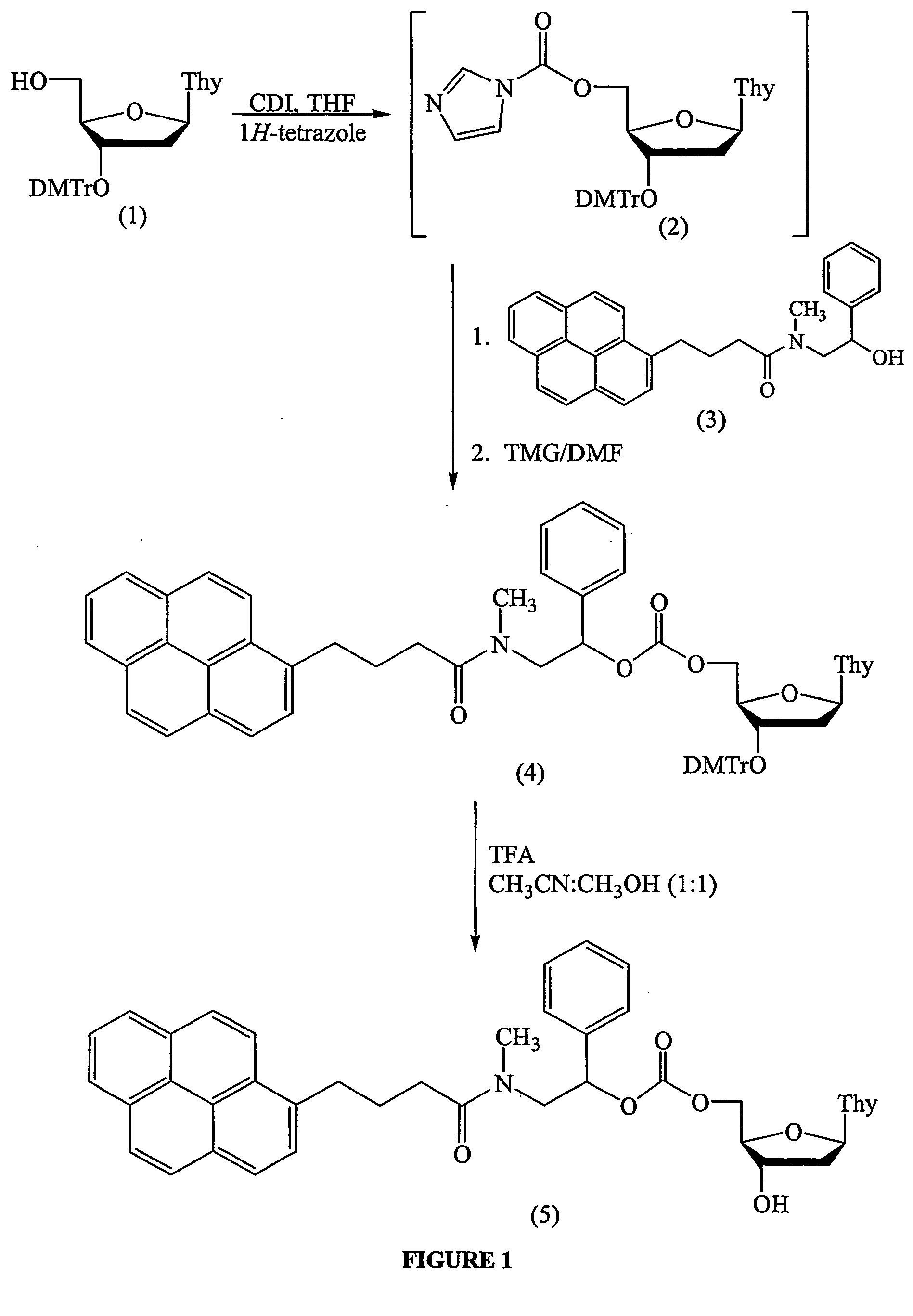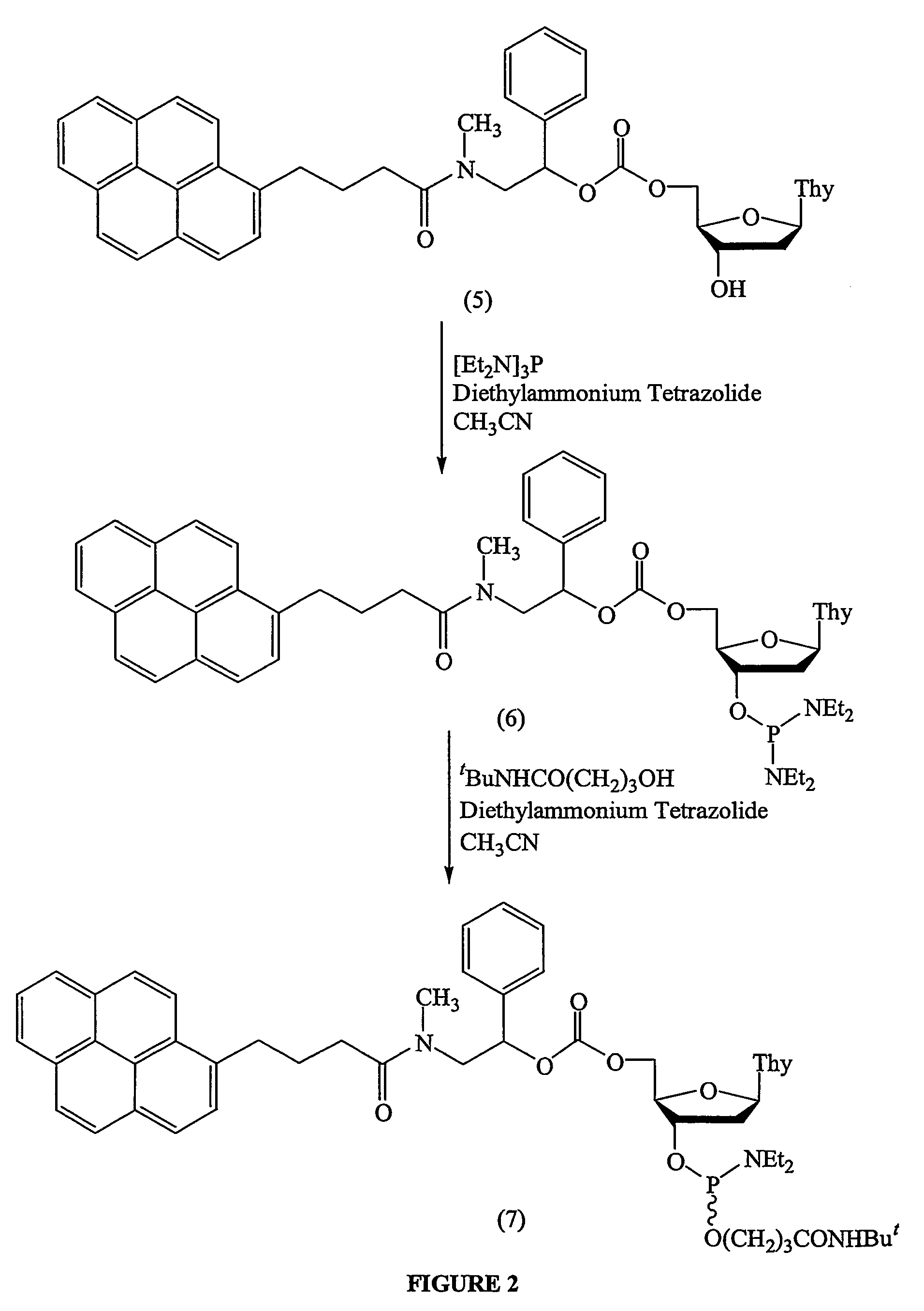Thermolabile hydroxyl protecting groups and methods of use
a technology of protecting groups and hydroxyls, applied in the field of thermally stable hydroxyl protecting groups, can solve the problems of limited range of structural oligonucleotide analogs that can be prepared using conventional hydroxyl protecting groups
- Summary
- Abstract
- Description
- Claims
- Application Information
AI Technical Summary
Benefits of technology
Problems solved by technology
Method used
Image
Examples
example 1
This example demonstrates the preparation of 5′-O-[2-[N-(1-pyrenylbutryl)-N-methyl]amino-1-phenylethyl]oxycarbonyl thymidine (5) (FIG. 1).
To 3′-O-(4,4′-dimethoxytrityl)thymidine (1) (680 mg, 1.25 nmol), 1,1′-carbonyldiimdazole (162 mg, 1.25 mmol), and 1H-tetrazole (175 mg, 2.5 mmol) in a flame-dried 4 mL glass vial, stoppered with a rubber septum, was added by syringe 2.5 mL of dry THF. The resulting solution is stirred at 25° C. for 1 h. TLC [EtOAc-hexane (7:3)] shows only a small amount of unreacted (1) (ca. 10-15%).
To the pyrenylamidobenzyl alcohol (3) (525 mg, 1.25 nmol) in a separate 4 mL flame-dried glass vial, stoppered with a rubber septum, was added by syringe tetramethylguanidine (TMG) (0.785 mL, 6.25 mmol), which had been dried over a 4 Å molecular sieves, and dry DMF (1 mL). The suspension was heated with a heat gun until a solution was obtained. The solution was then added by syringe to the CDI-activated nucleoside (2). The resulting brownish solution was stirred a...
example 2
This example demonstrates the preparation of 5′-O-[2-[N-(1 pyrenylbutyryl)-N-methyl]amino-1-phenylethyl] oxycarbonyl-3′-O-(3-tert-butylaminocarbonyl)propyl-1-oxy-N,N-diethylaminophosphinyl thymidine ((7), FIG. 2).
Equimolar amounts of (5) (0.25 nmol), hexaethylphosphorus triamide, and diethylammonium tetrazolide were mixed in dry methylene chloride (1.25 mL) for 30 min at 25° C. The deoxyribonucleoside 3′-O-phosphordiamidite (6) generated in situ was then reacted with an equimolar amount of 3-(tert-butylaminocarbonyl)propan-1-ol, and the reaction mixture was left stirring for at least 6 h at ambient temperature. The resulting deoxyribonucleoside phosphoramidite (7) was purified by silica gel chromatography and isolated as a white foam (˜90% yield).
example 3
This example demonstrates the preparation and thermal deprotection of a nucleoside bound to CPG support (FIG. 3).
Commercial LCAA-CPG (0.5 g) was washed with triethylamine and then reacted with ε-caprolactone (3 mL) for 3 days at 25° C. The support was then washed with MeOH, MeCN, and then dried under vacuum to afford (8).
The coupling of the pyrenyl deoxyribonucleoside phosphoramidite (7) to the CPG support (8) was performed as follows. To dry LCAA-CPG support (8) (˜10 mg) and dry pyrenyl deoxyribonucleoside phosphoramidite (7) (20 μmol) was added a 0.4 M solution of 1H-tetrazole in acetonitrile (0.200 mL). The suspension was gently shaken for 3 min and thoroughly washed with acetonitrile. The support was treated with a 0.02 M solution of iodine in THF:water:pyridine for 2 min and exhaustively washed with THF, MeOH, and MeCN to afford the functionalized support (9).
Cleavage of the 5′-O-protecting group from (9) (FIG. 3) was performed as follows. The functionalized support (9) ...
PUM
| Property | Measurement | Unit |
|---|---|---|
| Temperature | aaaaa | aaaaa |
Abstract
Description
Claims
Application Information
 Login to View More
Login to View More - R&D
- Intellectual Property
- Life Sciences
- Materials
- Tech Scout
- Unparalleled Data Quality
- Higher Quality Content
- 60% Fewer Hallucinations
Browse by: Latest US Patents, China's latest patents, Technical Efficacy Thesaurus, Application Domain, Technology Topic, Popular Technical Reports.
© 2025 PatSnap. All rights reserved.Legal|Privacy policy|Modern Slavery Act Transparency Statement|Sitemap|About US| Contact US: help@patsnap.com



